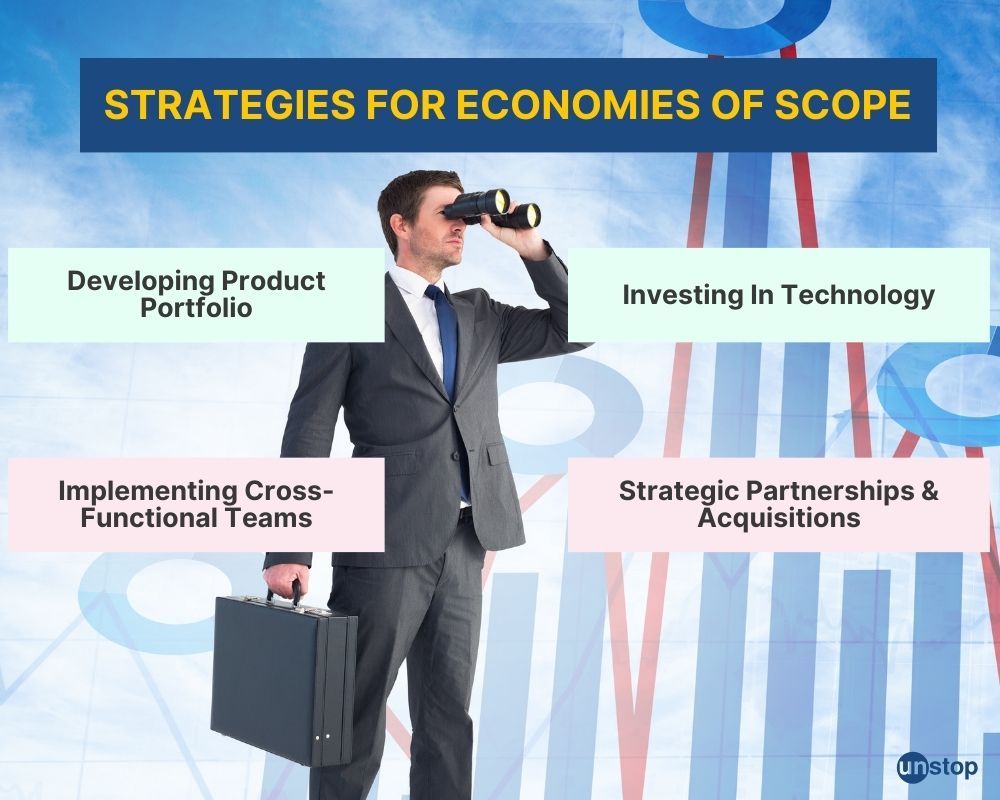- Definition & Benefits Of Economies Of Scope
- Examples Illustrating Economies Of Scope
- Strategies For Achieving Economies Of Scope
- Calculating Economies Of Scope With Example
- Economies Of Scope Vs Economies Of Scale
- Frequently Asked Questions (FAQs)
Economies Of Scope: Definition, Benefits, Strategies & Examples

Pursuing economies of scope allows companies to increase their market share and gain a competitive edge. This strategy enables businesses to achieve greater profitability and sustainability by realizing cost savings through shared resources and streamlined production processes. By exploring economies of scope, companies can expand their operations and offer a wider variety of products or services while optimizing their use of resources.
Definition & Benefits Of Economies Of Scope
Economies of scope refer to a situation where the average cost per unit decreases as a result of producing a wider range of products or services. This occurs when businesses share common inputs, such as raw materials, technology, or distribution channels across different product lines. The concept is based on the idea that combining diverse activities can lead to cost savings and operational efficiencies.
Economies of scope play a vital role in the success of businesses. By offering a variety of related products or services, companies can expand their customer base and tap into new markets. This strategy allows businesses to leverage their existing resources more effectively, resulting in cost savings and increased competitiveness.
Cost Advantage
One of the key advantages of economies of scope is the cost advantage it provides. When companies offer a range of related products or services, they can utilize their resources more efficiently.
 Image credit: Freepik
Image credit: Freepik
For example, a company that produces both smartphones and tablets can use the same manufacturing facilities and supply chains for both products. This reduces production costs as the company doesn't need to invest in separate facilities for each product line.
Reduce Distribution Costs
Economies of scope enable businesses to reduce distribution costs. When companies offer multiple related products or services, they can bundle them together for distribution. This means that instead of shipping each product individually, they can be packaged together and shipped as one unit. This consolidation reduces transportation costs and streamlines logistics operations.
Competitive Marketing
By achieving economies of scope, companies enhance their competitiveness in the market. Offering a variety of related products or services gives them an edge over competitors who may only specialize in one area. Customers are often attracted to businesses that provide a comprehensive solution rather than having to deal with multiple vendors for different needs.
Cross-Selling & Upselling
Another benefit is the opportunity for cross-selling and upselling. With economies of scope, companies can easily promote additional products or services to existing customers who have already purchased from them. For example, a telecommunications company that offers mobile phone plans could also sell internet packages or home phone services to its existing customer base. This not only increases revenue potential but also strengthens customer loyalty.
Examples Illustrating Economies Of Scope
Economies of scope can be seen in various industries, where companies leverage their resources to produce multiple products or services. Here are some examples illustrating this concept:
Automobile Manufacturer
An automobile manufacturer that produces both cars and motorcycles can benefit from economies of scope. By sharing components like engines or chassis across different vehicle types, the company can reduce costs per unit for each product. This means that the cost to produce each car or motorcycle is lower because they can use similar parts in their manufacturing process. For example, if a car and a motorcycle both use the same engine, the manufacturer can order these engines in bulk, resulting in lower costs per unit.
Fast-Food Chain
A fast-food chain that offers combo meals with various food items also achieves economies of scope. By utilizing similar ingredients across different meal options, they can streamline their operations and reduce costs.
 Image credit: Freepik
Image credit: Freepik
For instance, if a combo meal includes a burger, fries, and a drink, the chain can purchase these ingredients in bulk and distribute them across multiple orders. This allows them to take advantage of volume discounts and minimize waste. As a result, they can offer customers more affordable meals while still maintaining profitability.
Media Conglomerate
A media conglomerate that owns multiple television networks can leverage economies of scope by sharing content creation resources among its channels. Instead of creating unique content for each network, they can optimize production costs by reusing resources such as assets, equipment, or staff members. For instance, if two channels within the conglomerate want to produce talk shows on different topics but have similar formats, they could share studio space and production crews between the two shows. This not only reduces expenses but also increases efficiency in content creation.
Online Marketplace
An online marketplace that provides various product categories benefits from economies of scope through shared logistics infrastructure for efficient order fulfillment. By using a single warehouse to store products from different sellers or categories, the marketplace streamlines its operations and reduces costs associated with warehousing and shipping. For example, instead of having separate warehouses for electronics and clothing, the marketplace can consolidate inventory in one location, reducing storage costs and optimizing order processing. This allows them to offer competitive prices to customers while maintaining a profitable business model.
Strategies For Achieving Economies Of Scope
To achieve economies of scope, businesses can employ several strategies that enable them to optimize their operations and reduce costs.

Developing A Product Portfolio
One way to achieve economies of scope is by developing a product portfolio that complements each other. By offering a range of products or services that are related or interconnected, businesses can leverage shared resources and reduce production costs. For example, a company that manufactures both smartphones and smartwatches can benefit from economies of scope by sharing research and development efforts, manufacturing facilities, and distribution networks.
Implementing Cross-Functional Teams
Another strategy is to implement cross-functional teams within the organization. By creating teams that consist of members from different departments or divisions, businesses can streamline operations across different product lines. This approach encourages collaboration, knowledge sharing, and efficient decision-making. Cross-functional teams can help identify opportunities for synergy between different products or services, leading to cost savings and improved performance.
Investing In Technology & Systems
Investing in technology and systems is essential for achieving economies of scope. By adopting advanced technologies and implementing integrated systems, businesses can enhance the coordination and integration of diverse activities across different product lines. For instance, implementing an enterprise resource planning (ERP) system allows companies to manage various aspects such as inventory control, supply chain management, customer relationship management (CRM), and financials in a unified manner. This integration leads to improved efficiency, reduced duplication of efforts, and cost savings.
Forming Strategic Partnerships Or Acquisitions
Forming strategic partnerships or engaging in acquisitions is another effective strategy for achieving economies of scope. By partnering with other companies or acquiring existing businesses with complementary products or capabilities, organizations gain access to new markets while leveraging their existing strengths. For example, a clothing retailer might form a partnership with a shoe manufacturer to offer coordinated outfits or acquire a logistics company to improve its supply chain efficiency. These collaborations and acquisitions allow businesses to benefit from economies of scope by sharing resources, reducing costs, and expanding their customer base.
Calculating Economies Of Scope With Example
To determine if a company is achieving economies of scope, there is a simple formula that can be used:
Cost per unit with scope divided by cost per unit without scope. This formula allows us to compare the average cost per unit when producing multiple products or services together versus producing them individually.
Let's consider an example to illustrate this concept further. Suppose a company produces two different types of shoes: sneakers and sandals. If it costs $10 to produce one pair of sneakers alone and $8 to produce one pair of sandals alone, then we can calculate the respective costs per unit without scope as follows:
-
Cost per unit without scope for sneakers = $10
-
Cost per unit without scope for sandals = $8
Now let's assume that when these two types of shoes are produced together in a single manufacturing process, the total cost is $16 for both pairs combined. In this case, we can calculate the cost per unit with scope as follows:
-
Cost per unit with scope = $16 / 2 units = $8
Comparing the cost per unit with scope ($8) to the cost per unit without scope for each product shows that there are economies of scope present. It is more cost-effective to produce both sneakers and sandals together rather than producing them individually.
Calculating economies of scope helps businesses understand if they are optimizing their resources and maximizing efficiency in their operations. It provides insights into whether producing multiple products or services together leads to cost savings compared to producing them separately.
Economies Of Scope Vs Economies Of Scale
Economies of scope and economies of scale are both concepts related to cost advantages in business, but they focus on different aspects. While economies of scale are achieved through increased production volume, economies of scope emphasize the benefits of diversification.
Economies Of Scope
On the other hand, economies of scope arise from sharing common inputs across different products or services within a company. Instead of focusing solely on increasing production volume like economies of scale, businesses that pursue economies of scope aim to broaden their product/service offerings while utilizing existing resources efficiently. By diversifying their product lines or expanding into related markets, companies can leverage shared resources such as technology, distribution networks, or expertise. This allows them to reduce costs compared to maintaining separate operations for each product/service line.
Unlike achieving economies of scale which often requires higher production quantities to spread fixed costs effectively, attaining economies of scope does not necessarily depend on high volumes. Even with lower output levels for each product/service offered within a diversified portfolio, companies can still benefit from cost efficiencies derived from shared resources.
Economies Of Scale
Economies of scale occur when a company can lower its average costs by producing more goods or services. This is because fixed costs, such as machinery or infrastructure, can be spread over a larger output. In other words, as production quantity increases, the cost per unit decreases. Achieving economies of scale typically requires higher production volumes. By producing more units, companies can take advantage of bulk purchasing discounts, negotiate better deals with suppliers, and optimize their manufacturing processes. As a result, they can reduce per-unit costs and increase profitability.
Summary
In summary, to capitalize on economies of scope, companies should carefully analyze their existing resources and capabilities to identify opportunities for diversification. They should also consider strategic partnerships or acquisitions that can enhance their product portfolio and create synergistic effects. By constantly evaluating market trends and consumer demands, businesses can adapt their strategies accordingly to maximize the benefits of economies of scope.
Frequently Asked Questions (FAQs)
1. How do economies of scope differ from economies of scale?
Economies of scale relate to cost advantages achieved through increased production volume, whereas economies of scope pertaining to cost advantages gained by producing a variety of products or services together. While both concepts focus on reducing costs per unit produced, they operate at different levels - scale refers to increasing output for a single product line while scope involves diversifying across multiple products or services.
2. Can you provide an example illustrating economies of scope?
Certainly! An example would be a car manufacturer that produces both sedans and SUVs using the same assembly line facilities. By sharing resources like machinery, labor force, and supply chains between these two distinct product lines instead of having separate facilities for each type, the manufacturer can achieve cost savings through economies of scope.
3. Are economies of scope applicable to all industries?
Economies of scope are particularly relevant in industries where there are synergies between different products or services, allowing for the sharing of resources and cost reductions. However, the extent to which economies of scope can be realized may vary across industries depending on factors such as market demand, production processes, and the level of product differentiation.
4. How can a company determine if it is achieving economies of scope?
To evaluate whether a company is benefiting from economies of scope, it can calculate the cost savings achieved by producing multiple products together compared to producing them separately. By analyzing the difference in costs and efficiencies between integrated production and separate production methods, companies can assess their performance in realizing economies of scope.
5. What are some potential risks or challenges associated with pursuing economies of scope?
While economies of scope offer numerous benefits, there are also potential risks involved. Companies may face difficulties in effectively managing a diverse range of products or services and ensuring consistent quality across all offerings. If market conditions change or consumer preferences shift significantly, companies heavily reliant on economies of scope may find it challenging to adapt quickly to new demands.
Suggested reads:
- Consumer Surplus: Definition, Calculation, Examples & Limitations
- Capitalist Economy: Definition, Evolution, Features & Merits
- What Is Trade Union? Learn Its Definition, Evolution, Types & Functions
- Law Of Diminishing Marginal Utility: A Comprehensive Analysis With Examples
- Marginal Utility Explained: From Evolution To Current Use
Instinctively, I fall for nature, music, humor, reading, writing, listening, traveling, observing, learning, unlearning, friendship, exercise, etc., all these from the cradle to the grave- that's ME! It's my irrefutable belief in the uniqueness of all. I'll vehemently defend your right to be your best while I expect the same from you!
Login to continue reading
And access exclusive content, personalized recommendations, and career-boosting opportunities.
Subscribe
to our newsletter
















Comments
Add comment